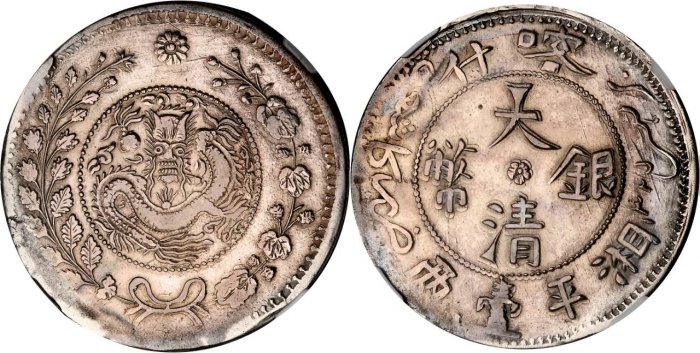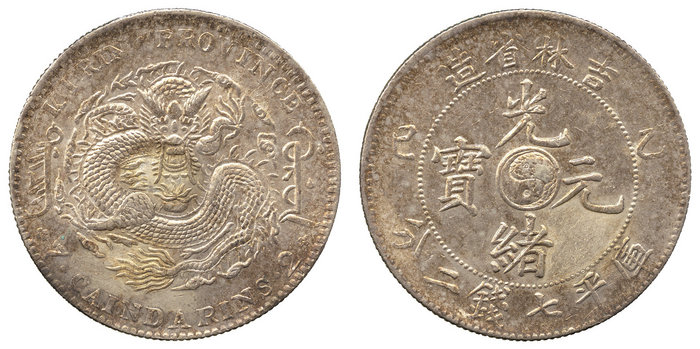Last month I posted an article about how getting back to the basics and just weighing and ringing coins allowed me to identify a very good quality fake chinese coin. However, this is not a silver bullet. In that particular case, it was important, because Fengtien coins were always minted up to standard – they all weigh 7 maces and 2 candarins, using the 庫平 (Ku Ping) standard.
However, this is not the case for some provinces. For example, coins minted in Sinkiang (新疆) province used the 湘平 (Xiang Ping) standard: a Xiang Ping Tael is equivalent to 36.1 grams (1.16 oz). The Ku Ping Tael weighs 37.3 grams (1.2 oz), over 1 gram more. A collector carefully weighing a recently acquired Sinkiang tael and remembering that chinese taels should weigh about 37 grams would then be surprised to find his coin to be 1 gram “underweight”. It is actually normal, just an artifact of the byzantine currency rules in the late Qing era.
Aside of these competing currency standards, some provincial mints also issued deliberately debased or sloppily minted coins. The Kirin (吉林) provincial mint is a well known offender in that category. Coins with the “7 mace and 2 candarins” denomination following the Ku Ping standard should weigh 26.84 grams (0.86 oz), but some coins minted in Kirin are clearly underweight.
For example, the Kirin dollar above weighs 25.6 grams, but is completely genuine. As a rule of thumb, coins issued by Kwang Tung (广东), Hu Peh (湖北), Sze Chuan (四川), Kiang Nan (江南), Fungtien (奉天), and Pei Yang (北洋) mints as well as imperial issues are close enough to the standard to dismiss underweight coins as forgeries. However, one should still be aware there is some genuine overweight Pei Yang dollars (27 grams) or underweight Kiang Nan coins.
The variations in provincial coinage, added to the complicated currency rules, greatly helped the Yuan Shi Kai dollar to succeed later. It had a consistent weight and value all across China, simplifying greatly inter-provincial transactions.
In conclusion, one should not rely on some simple rules to evaluate if a Chinese coin is genuine or fake. Knowing intimately the intricacies of their design is important, but weight and metal composition should not be neglected. Relying solely on the weight would be an error nonetheless. There is some very well executed forgeries made from the original metal of melted lesser chinese coins circulating on the market. Therefore, always keep in mind this wise chinese saying “不懂不买” when shopping for coins – it simply means: “don’t buy if you don’t know what you’re buying”…
Learn more about Chinese coins!
No related Dragon Dollar article


Very good reference for any China coins collector or amateur.
Would be good if the compositions of the coin materials can be provided, i.e. 100% silver or a mixture of whatever so that this can be part of identifying the “silver” Chinese coins.
Unfortunately, the metal composition of Chinese coins varies greatly depending of the mint and year of production… Coins that were minted up to standard (imperial issues from Tianjin, for example) weighed 26.9 grams and used 0.9 Silver, for a 0.7783 troy ounce ASW (about 24.20 grams).
I have many Tael, Silver Dollars and Trade Dollars from the Empire, Provence, Republic eras. They all respond to a magnet to varying degrees. I weighed one “Fat Boy” coin on my food scale and it was 22g (not troy but standard measure). I do believe they are true to their time period of ~1889 to 1927 or later because the person I bought them from said they were his grandfather’s coins which would be the same time frame. Do you think there is any chance they may be real or worth anything? If magnetism is not a sure way to test Chinese Empire era silver dollars for their authenticity then I will weigh the rest.
Hello, I’m sorry but the person who sold you the coin was dishonnest. Genuine Chinese coins were made of Silver or Copper, and are never magnetic. Please ask for a refund! By the way, the “grandfather story” is unfortunately very common to the point of almost being a red flag.
i have a unique dragon coin of almost same as that of (Ku Ping Tael weighs 37.3 grams (1.2 oz), over 1 gram more) interested buyer can contact on mi Facebook of same email address. real face book name is (karmandoo dorji ).
thanks
Thanks for this explanation, I’m working on a Kirin dollar, and your site has helped me start a judgement. Appreciate your hard work and willingness to share data.
I appreciate the valuable information you are providing here. I am, however, novice to the point of not even knowing how to convert terms like maces and candarins. What are the equivalents of these weight measures in modern or common terms? Thank you!
Hello, according to the Kuping (庫平) standard, one Tael was equal to 37.5 grams, one Mace to 3.75 grams and one Candareen to 0.375 gram. 7 Mace and 2 Candareens was therefore 27 grams.
Hi there I also have a dragon dollar coin and it is NOT magnetic on a silver magnet, what are some options you can give me apart from weight and diameter, that I can do to make sure that my coin is NOT FAKE but an authentic rare one
You can try computing the density of your coin. You can use this formula: (weight of the coin) / (π x (half of the diameter of the coin)² x (thickness of the coin)). For exemple, an American Morgan dollar have a weight of 26.73 grams, diameter of 38.1mm and 2.4mm thickness, so when we apply the formula: 26.73 / (π x 19.05² x 2.4) we find a density of 9.77g/cm³. Chinese Silver Yuan were made to the same specifications than American Silver dollars, so if your coin has a density significantly different from 9.77g/cm³, it may be fake.
You can also send pictures of your coin for a free appraisal: http://www.dragondollar.com/coins/coin-appraisal-what-is-your-chinese-coin-worth/